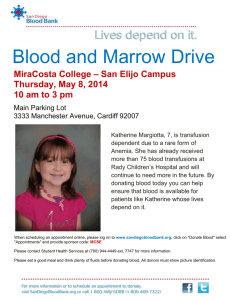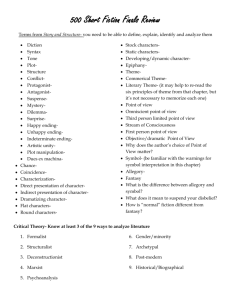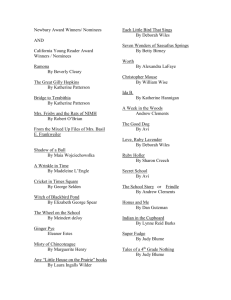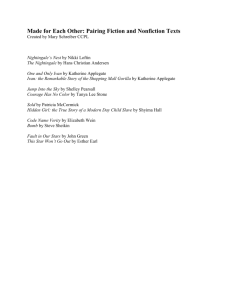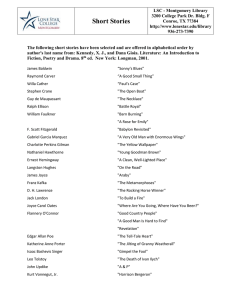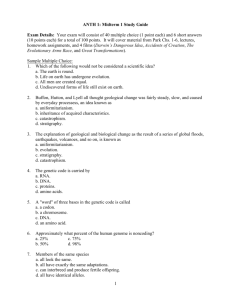317 Katherine Rural Review
advertisement
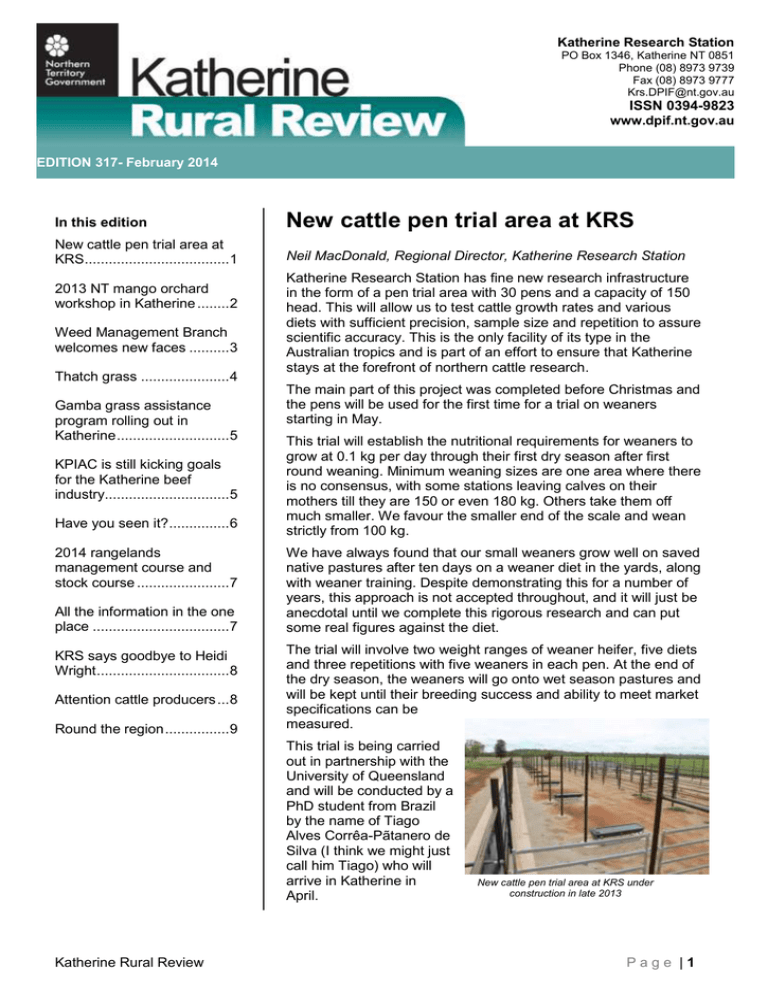
Katherine Research Station PO Box 1346, Katherine NT 0851 Phone (08) 8973 9739 Fax (08) 8973 9777 Krs.DPIF@nt.gov.au ISSN 0394-9823 www.dpif.nt.gov.au EDITION 317- February 2014 In this edition New cattle pen trial area at KRS New cattle pen trial area at KRS .................................... 1 Neil MacDonald, Regional Director, Katherine Research Station 2013 NT mango orchard workshop in Katherine ........ 2 Weed Management Branch welcomes new faces .......... 3 Thatch grass ...................... 4 Gamba grass assistance program rolling out in Katherine ............................ 5 KPIAC is still kicking goals for the Katherine beef industry............................... 5 Have you seen it? ............... 6 2014 rangelands management course and stock course ....................... 7 All the information in the one place .................................. 7 KRS says goodbye to Heidi Wright ................................. 8 Attention cattle producers ... 8 Round the region ................ 9 Katherine Research Station has fine new research infrastructure in the form of a pen trial area with 30 pens and a capacity of 150 head. This will allow us to test cattle growth rates and various diets with sufficient precision, sample size and repetition to assure scientific accuracy. This is the only facility of its type in the Australian tropics and is part of an effort to ensure that Katherine stays at the forefront of northern cattle research. The main part of this project was completed before Christmas and the pens will be used for the first time for a trial on weaners starting in May. This trial will establish the nutritional requirements for weaners to grow at 0.1 kg per day through their first dry season after first round weaning. Minimum weaning sizes are one area where there is no consensus, with some stations leaving calves on their mothers till they are 150 or even 180 kg. Others take them off much smaller. We favour the smaller end of the scale and wean strictly from 100 kg. We have always found that our small weaners grow well on saved native pastures after ten days on a weaner diet in the yards, along with weaner training. Despite demonstrating this for a number of years, this approach is not accepted throughout, and it will just be anecdotal until we complete this rigorous research and can put some real figures against the diet. The trial will involve two weight ranges of weaner heifer, five diets and three repetitions with five weaners in each pen. At the end of the dry season, the weaners will go onto wet season pastures and will be kept until their breeding success and ability to meet market specifications can be measured. This trial is being carried out in partnership with the University of Queensland and will be conducted by a PhD student from Brazil by the name of Tiago Alves Corrêa-Pãtanero de Silva (I think we might just call him Tiago) who will arrive in Katherine in April. Katherine Rural Review New cattle pen trial area at KRS under construction in late 2013 Page |1 2013 NT mango orchard workshop in Katherine Grant Cutler, Technical Officer, Katherine Research Station In early December, Katherine Research Station hosted a Northern Territory mango orchard nutrition workshop in conjunction with guest speaker Ted Winston from Tropical Horticultural Consulting in Queensland. The aim of this workshop was to provide growers and agribusiness advisors with outlined key strategies for the development and maintenance of healthy and productive orchards that can deliver quality fruit. The workshop covered most aspects of mango orchard nutrition from essential nutrients such as nitrogen and potassium, through to timing of application during specific annual phenological events for maximum effectiveness. The role of four important elements (nitrogen, calcium, boron and potassium) was discussed in depth, covering areas from their specific roles in mango orchards and effect on mango production to correct application rates and timing. The summary of this section of the workshop outlined that nitrogen and calcium act as building blocks for tree health and fruit quality whilst boron activates with potassium and is responsible for the size and sweetness of the fruit. The final area covered in the workshop outlined the effect soil pH has on mango production and the overall health of mango orchards. After lunch the group travelled to Piñata Farm to partake in a particle demonstration of soil sampling and leaf sampling techniques. The sampling, under Ted’s supervision, gave a good demonstration of the recommended procedure for sampling and the correct areas where samples should be taken. Soil samples are commonly taken to determine nutrient levels within the soil and their availability to the plant. Leaf sampling was also demonstrated as a method for determining nutrient levels within the trees themselves. Using both methods allows a suitable nutrition program to be implemented. Page |2 Overall it was an enjoyable and informative workshop with thanks going out to the local producers and agronomists who participated. Additional and resounding thanks to Ted Winston for sharing his knowledge. Special thanks also go to Horticulture Australia (HAL) and the Australian Mango Industry Association for funding this activity. For more information on mango orchard nutrition contact Ted Winston (Tropical Horticultural Consulting) on (07) 4068 8796 or Warren Hunt (DPIF) on (08) 8999 2143. Ted Wilson (THC) and Sarah Phillips (DPIF) survey leaf samples taken during the practical field session Katherine Rural Review Weed Management Branch welcomes new faces The Department of Land Resource Management is pleased to introduce three starters to the Katherine Region Weed Management Branch. Kirsten Tasker started working with the Weed Management Branch in August 2013. Kirsten hails from South East NSW and was previously working in Ranger and Firefighting roles throughout NSW and the ACT. Since starting with the Weed Management Branch, Kirsten has been busy surveying and managing rubber vine in the Gulf Country, chinee apple throughout the Katherine township and other priority weeds in the Katherine region. In her spare time Kirsten enjoys motocross riding, so if you see her down at the motorcycle club, be sure to say hello. Will Parker joined the Weed Management Branch in December 2013 after moving to Katherine from Melbourne. Will has a background in ecological consulting and catchment management in Victoria. Since Will’s commencement, he has had involvement in grader grass herbicide trials and has been busy getting up to date with the major weed issues affecting the Katherine region. Since moving to the NT, Will has been playing AFL for the Wanderers in Darwin. He is looking forward to getting involved with one of the local sides in the Katherine competition this dry season. The Katherine Weed Management Branch is aiming to extend their services further in 2014 with the increase in staff, and a focus on pastoral land. Staff will be contacting landholders throughout the region in the immediate future to organise weed mapping, identification, and control projects. If you would like to find out more about extension services, contact the Weed Management Branch in Katherine. Office Depot 32 Giles Street, Katherine Monday–Friday 8.00 am–4.21 pm Phone 08 8973 8857 11 Crawford Street, Katherine Friday 1.00 pm–4.15 pm Katherine Rural Review Page |3 Thatch grass Control this potential weed before it becomes established in the NT Thatch grass (Hyparrhenia rufa) is a competitive, introduced grass that was previously trialled in the Northern Territory as a pasture species, but is no longer recommended or used. It is well adapted to fire, and once established in an area it can increase fuel loads, resulting in higher fire frequency and intensity. Evaluation through the Northern Territory Weed Risk Assessment System found thatch grass to be a high weed risk, but that the opportunity exists for effective control due to its current limited distribution. In accordance with these findings, it was recently declared a Class A weed in accordance with the Weeds Management Act and must be eradicated. In the Northern Territory, thatch grass is restricted to a relatively small number of locations around Darwin, Palmerston and other parts of the Top End. Because thatch grass distribution remains limited, there is still opportunity to avoid the impacts which are seen interstate and overseas. The early onset of the Wet season means that thatch grass should be controlled now, while it is actively growing, but before it sets seed. It is readily controlled with glyphosate herbicides, although it requires a 2% solution, double that required for gamba and mission grass. Weeds Branch do not think that thatch grass has persisted in the Katherine region, even though it was trialled in the area probably in the 1980s. If you think you may have thatch grass on your property, please contact the Katherine Weeds Branch. It is recommended that land managers learn to recognise thatch grass, so that it can be treated as soon as possible and so that spread can be prevented. The Weed Management Branch can assist with identification and recommend appropriate management actions. Phone 8973 8857 or visit the web site www.nt.gov.au/weeds Page |4 Thatch grass was one of five weed species declared in 2013, with the other species being: leaf cactus (Pereskia aculeata) Class A (to be eradicated) fountain grass (Cenchrus setaceus) Class B (growth and spread to be controlled) Brazilian pepper (Schinus terebinthifolius) Class A (to be eradicated north of 18° latitude) Class B (growth and spread to be controlled south of 18° latitude) parrot’s feather (Myriophyllum aquaticum) Class A (to be eradicated). Information on these species, as well as the attached identification sheet and weednote for thatch grass, is available online at www.nt.gov.au/weeds Vinod Chejara, formerly of the Weed Management Branch, showing the distinctive thatch grass seed heads that can normally be seen around April or May Katherine Rural Review Gamba grass assistance program rolling out in Katherine Gamba grass was introduced into the Northern Territory as a pasture grass in the 1930s. Ensuing research and trials showed gamba grass to be a highly productive and palatable fodder in pastoral and agricultural areas of the Top End. It is acknowledged that gamba grass can provide valuable grazing in the NT, but it needs intensive grazing management to ensure it does not set seed and invade into nonpasture areas. Gamba grass was declared a weed in the NT in 2010. The Gamba Grass Weed Management Plan 2010 and declaration zones are currently being reviewed, but gamba grass is considered a Class B weed north of the Katherine River, meaning its growth and spread needs to be controlled. It is a Class A weed south of the Katherine River, which means it needs to be eradicated, although a permit to use a declared weed may be granted in specific situations within the Class A zone. This means that all landholders in the Katherine Region should be diligent about controlling gamba grass, especially near Katherine township. Huge gamba infestations in the Darwin Rural Area have significantly increased the risk of extreme dry season fires which can threaten people and property, and modify the vegetation communities and biodiversity. Weeds Branch do not want this situation to develop in Katherine, where communities and residents in areas such as along Florina Road, the Victoria Highway, the Venn blocks and Stuart Estate would be threatened in cases of intense fires. The 2013–14 Gamba Grass Assistance Program commenced on 26 November 2013. The program provides free herbicide, planning and weed management advice, and spray equipment loans to private properties as a means to increase the land manager’s ability to control gamba grass and reduce existing infestations in affected areas. The Katherine distribution point is at the Weeds Branch Crawford Street depot, which is open on Friday afternoons. This season will also see the Weeds Branch increasing liaison with participants in the program to ensure they are getting the most out of their herbicide. Please contact the Katherine Weeds Management Branch (8973 8857) if you require more information. Brad Sauer, Katherine District Weeds Officer, ready to hand out herbicide for the Gamba Grass Assistance Program KPIAC is still kicking goals for the Katherine beef industry The Katherine Pastoral Industry Advisory Committee (KPIAC) was injected with some new blood in 2013, with three new members joining the committee (Carley Bidstrup from Montejinni Station, Lisa Dyer from Sturt Plains Station and Robert Venturin from Murranji Station). Sadly, we farewelled a valued member, Henry Townsend, and nearly said goodbye to Tony Searle! Tony has moved interstate but is still actively involved in the NT pastoral industry through his consultancy services, and remains on the committee as a Top End representative. Katherine Rural Review KPIAC meets twice a year, as well as responding to special out-of-meeting items through teleconference calls or emails. KPIAC serves two main roles; to advise DPIF on its research, development and extension priorities; and to act as one of the 11 northern Australian regional beef research committees. Keith Holzwart, the Chair of KPIAC, also Chairs the Northern Beef Industry Committee (NBIC) which is made up of 11 northern producer group Chairs. NBIC determines which northern beef projects are funded by MLA. Altogether, about a month of Keith’s time every year is spent in these roles, which is an amazing commitment. Page |5 If you have any burning research ideas, feel free to contact a KPIAC member, or the Katherine Pastoral Production team. Member Keith Holzwart (Chair) Tony Searle Allan Andrews The 11 regions of the northern Australian beef research committee As well as providing valuable feedback to DPIF throughout the year regarding new and ongoing projects, the committee also had a big win. Keith’s persistence ensured the support and funding of a collaborative genetics project lead by the Animal Genetics and Breeding Unit of University of New England (AGBU) and including Queensland’s Department of Agriculture, Fisheries and Forestry (QDAFF) and NT DPIF. This project involves the Selected brahman herd and aims to increase the accuracy of current fertility trait Estimated Breeding Values (EBVs), and potentially develop new fertility EBVs. The ultimate goal of the project is to lift weaning rates in northern Australia through improved genetics in the major tropical breeds. Mick Underwood Helen Armstrong Steve Petty Shane McWhirter Jay Mohr-Bell Carley Bidstrup Lisa Dyer Robert Venturin Graeme Fagan Company Avago Station Searle Pastoral Management Services Consolidated Pastoral Company (CPC) Riveren Station Gilnockie Station Northern Development Company Indigenous Land Corporation (ILC) Mathison Station Montejinni Station Sturt Plains Station Murranji Station Department of Land Resource Management Have you seen it? Thinking of investing in some new technology in 2014 but don’t know where to start? Well, Sally Leigo and the CRC-REP team have taken all the hard work out of it for you. Whether you’re thinking of something pasture or cattle related, this review will help you decide which product is the most relevant to you and your desired outcome. The review has grouped each product on the basis of operation and purpose for easy comparison. Groups include: Each product reviewed has information detailing its application, features, requirements and availability. Readers may be surprised by the number of do-it-yourself mapping and cattle record keeping programs currently available. Overview of technology products for the beef industry of remote Australia is available for free. Download it from http://bit.ly/RXm5fB remote pasture monitoring pasture modelling mapping programs management software remote monitoring of cattle herd modelling remote management livestock management software. Page |6 Katherine Rural Review 2014 rangelands management course and stock course Expressions of interest An interactive course developed for station staff to enhance their skills and knowledge in the area of land and production system management in the VRD/Katherine or Sturt Plateau regions. What: 1½–2 day course covering pasture species; dynamics and management; weed management and poisonous plants; animal nutrition; and biodiversity Where: On-station When: March–May, dates on request from stations For more information or to organise a course on your station, please contact: Trudi Oxley Jodie Ward (08) 8973 9763 (08) 89739 730 Trudi.Oxley@nt.gov.au Jodie.Ward@nt.gov.au All the information in the one place FutureBeef is a collaborative program for the northern Australia beef industry with partners Northern Territory Department of Primary Industry and Fisheries (DPIF); Queensland Department of Agriculture, Fisheries and Forestry (DAFF); Western Australia Department of Agriculture and Food (DAFWA); and Meat & Livestock Australia (MLA). What does this mean for you? The aim of the FutureBeef program is to support sustainable and profitable productivity gains for northern beef producers by building on and complementing: This month’s hot topics: investment and outcomes of past and future research, development and extension (RD&E) conducted by FutureBeef partners and industry the sharing and collaborative development of information, knowledge and resources to more effectively service industry delivery of ‘National Beef Production RD&E Strategy’ outcomes. Katherine Rural Review It means that all the information you might require for managing beef cattle in northern Australia is all in the one place! Whether you require information on supplementation strategies, calculating forage budgets, or effective vaccination procedures, there’s only one place to go: futurebeef.com.au release of Guidelines for the development of extensive cattle stations in northern Australia, insights from the Pigeon Hole Project calculating forage budgets—a series of four YouTube tutorials with Col Paton an update of the Fixed Time Artificial Insemination and Polled Gene Marker Test Producer Demonstration Site underway at Lakefield Station and Avago Station. For the latest project results and upcoming events, follow us on Twitter or like us on Facebook. Page |7 KRS says goodbye to Heidi Wright In April 2012, Heidi Wright came to join us at Katherine Research Station as the Operations Officer for FutureBeef, the DPIF’s extension collaboration with Qld, WA and MLA. The initial three month contract required Heidi to not only create but also apply and teach others about the FutureBeef social media communication strategy. This was no small undertaking, but Heidi managed to achieve this and more as the rest of us at KRS stood back in amazement. Before long, Heidi’s contract had been extended and her list of responsibilities quickly grew. Some of Heidi’s duties included creating displays for the Katherine Show, co-ordinating the 2013 Farm and Garden Day, producing, filming and editing the soon-to-be released weaner handling DVD, website development, and media work, to name just a few. It is with sadness that the staff of KRS and FutureBeef team members from across northern Australia say goodbye to Heidi as she and husband James Wright (formerly Gulf Savannah Regional Coordinator for Territory NRM) move to the family property in northern NSW. We would like to wish Heidi and James all the very best for the future. Attention cattle producers Have you moved cattle into the Parkhurst Tick Infected Zone (red) in the Darwin region for export or agistment? If so, could any of these cattle be returning to your property? Have you organised for a Livestock Biosecurity Officer to: clean inspect these cattle have a supervised treatment with an Amitraz plunge dip before leaving the Parkhurst Tick Zone? Please contact a Livestock Biosecurity Officer in Darwin to organise an inspection prior to movement. Phone (08) 8999 2030 or (08) 8999 2034 Importing untreated cattle can not only lead to quarantine and strict movement restrictions for your property, but also puts the rest of the cattle industry at risk and limits effective chemicals available for plunge dips and the end of Bayticol® use. Importing untreated cattle is an offence under the Livestock Act and may result in prosecution. Page |8 Katherine Rural Review Round the region KRS staff were recently treated to a demonstration of the capabilities of new technology. 1. Up close with a drone 2. An example of how a drone can be used in agriculture. This drone has the capacity to survey crops remotely as it has video cameras built in and the ability to feed real-time footage back to a headset 3. Trish watching the live footage from the drone through the headset Katherine Rural Review Page |9 DEPARTMENT OF PRIMARY INDUSTRY AND FISHERIES Pastoral market update Live cattle exports via Darwin Port—January 2014 # Please note that the ‘NT CATTLE’ figures are NT cattle exported through the Port of Darwin only—some NT cattle are exported through interstate ports. Destination TOTAL CATTLE (including interstate) 2012 Brunei Previous YTD year 31/1/13 31/1/14 2013 1-31 JAN # NT CATTLE Previous month 2012 Previous YTD year 31/1/13 31/1/14 2013 Difference 1-31 JAN Previous month Difference 4,639 4,043 0 0 0 0 0 4,639 4,043 0 0 0 0 0 Indonesia 201,748 282,022 27,647 11,923 11,923 67,031 -55,108 189,994 243,978 24,047 6,423 6,423 61,351 -54,928 Philippines 27,324 22,403 0 0 0 2,416 -2,416 26,337 15,063 0 0 0 2,416 -2,416 460 0 0 0 0 0 0 460 0 0 0 0 0 0 0 800 0 0 0 0 0 0 800 0 0 0 0 10,018 14,952 1,299 0 0 0 0 10,018 12,094 1,299 0 0 0 0 2,801 35,396 0 1,414 1,414 0 +1,414 2,801 32,806 0 1,414 1,414 0 +1,414 0 0 0 0 0 0 0 0 0 0 0 0 0 0 246,990 359,616 28,946 13,337 13,337 69,447 -56,110 234,249 308,784 25,346 7,837 7,837 63,767 -55,930 Sabah Sarawak W-Malaysia Vietnam Egypt TOTAL -15,609 -17,509 January at a glance TOTAL Live Cattle Exports through Port of Darwin 2013 v 2014 Cattle Head 13,337 head of cattle through the Port of Darwin during January—56,110 fewer than December and 15,609 fewer than January 2013 2014 total cattle figures indicate 16,609 head fewer than last year. NT cattle 17,509 fewer than 2013 Live Cattle Exports through the Port of Darwin (previous 10 years) 70,000 65,000 60,000 55,000 50,000 45,000 40,000 35,000 30,000 25,000 20,000 15,000 10,000 5,000 0 1 2 3 4 5 7 8 9 10 11 12 2013 400,000 2014 350,000 Cattle Head 6 300,000 NT Live Cattle Exports through Port of Darwin 2013 v 2014 250,000 200,000 150,000 50,000 0 2002 2003 2004 2005 2006 2007 2008 2009 2010 2011 2012 2013 Total Cattle NT Cattle Cattle Head 100,000 70,000 65,000 60,000 55,000 50,000 45,000 40,000 35,000 30,000 25,000 20,000 15,000 10,000 5,000 0 1 2 3 4 5 6 7 8 9 10 11 12 2013 2014 PREVIOUS 8 YEARS Total Cattle, Port of Darwin 2006 227,648 2007 283,046 2008 364,944 2009 347,314 2010 295,605 NT Cattle, Port of Darwin 2011 269,617 2012 246,990 2013 359,616 2006 223,407 2007 247,281 2008 295,539 2009 304,818 2010 272,749 2011 253,797 Other livestock exports via Darwin Port (includes NT and interstate stock) PAGE 1 2012 234,249 2013 308,784 Pastoral Market Update – January 2014 Destination 2013 Buffalo 2014 1-31 JAN Camels 2014 1-31 JAN 2013 0 2013 Goats 2014 1-31 JAN 2013 Horses 2014 1-31 JAN 2013 Sheep 2014 1-31 JAN 2013 Pigs 2014 1-31 JAN Brunei 400 0 0 0 0 1080 0 0 0 0 0 0 0 0 0 0 0 Indonesia 201 0 0 0 0 0 0 0 0 0 0 0 0 0 0 0 0 0 Philippines 199 0 0 0 0 0 0 0 0 0 0 0 0 0 0 0 0 0 W-Malaysia 0 0 0 0 0 0 0 0 0 0 0 0 0 0 0 0 0 0 Sabah 0 0 0 0 0 0 0 0 0 0 0 0 0 0 0 0 0 0 Sarawak 0 0 0 0 0 0 0 0 0 0 0 0 0 0 0 0 0 0 TOTAL 800 0 0 0 0 0 1080 0 0 0 0 0 0 0 0 0 0 0 National cattle prices—W/E 31/1/2014 HEAVY STEER MEDIUM STEER Estimated dressed weight price (cents/kg) SALEYARDS NSW QLD This week 321 323 Last week 298 290 Year ago 326 320 Estimated dressed weight price (cents/kg) O.T.HOOKS SA SALEYARDS AV (Aust) NSW QLD SA AV (Aust) nq 318 322 315 Nq 323 nq 291 322 315 Nq 323 nq 299 322 315 nq 313 QLD This week 303 301 nq Last week 288 283 293 Year ago 334 325 nq MEDIUM COW SA AV (Aust) NSW QLD SA AV (Aust) 300 317 308 Nq 320 288 317 308 Nq 320 314 314 300 Nq 309 TRADE STEER Estimated dressed weight price (cents/kg) SALEYARDS O.T.HOOKS NSW Estimated dressed weight price (cents/kg) O.T.HOOKS SALEYARDS NSW QLD SA AV (Aust) NSW QLD SA AV (Aust) This week 205 247 241 215 252 283 235 253 Last week 198 221 233 209 252 283 235 253 Year ago 277 273 208 263 265 285 220 252 O.T.HOOKS NSW QLD SA AV (Aust) NSW QLD SA AV (Aust) This week 314 314 284 Last week 330 308 280 310 327 340 310 321 316 327 340 310 Year ago 364 nq 257 321 336 325 308 310 313 LIVE EXPORT QUOTES Estimated live weight price (cents/kg) LIGHT STEERS (260-360 kg) Darwin Broome Prices courtesy of Meat & Livestock Australia LIGHT HEIFERS (260-360 kg) Darwin Broome This week 230 nq 210 nq Last week 230 nq 210 nq Year ago nq nq nq nq www.mla.com.au Currency exchange rates Key currencies Current Previous month 3 months ago 1 Year ago Pre-devaluation 1AUD = 3.2.2014 1.1.2014 1.11.2013 1.2.2013 01.07.1997 Brunei Dollar 1.10745 1.10893 1.15885 1.27334 1.076 Indonesian Rupiah 10,629.9 10,640.5 10,564.4 10,101.6 1830 Philippine Peso 39.4786 40.0574 40.8904 42.5191 19.84 Malaysian Ringgit 2.92247 2.94686 2.98597 3.20701 1.9 Euro 0.64871 0.64998 0.69005 0.7621 N/A US Dollar 0.87484 0.88040 .94868 1.04451 0.752 Vietnam Dong 18,248.3 Prepared by the NT Department of Primary Industry and Fisheries This publication contains commodity market information prepared for DPIF staff use in strategic research and extension planning. While DPIF exercise care in the compilation and preparation of this information, no responsibility is taken for its accuracy or for the completeness of any information that is reproduced from other sources. DPIF denies any loss or damage to any person whether caused directly or indirectly by the use of any of the information provided. PAGE 2 Katherine region events calendar Event Location Date Mango Research, Development and Extension Forum NT Cattlemen’s Association Conference and AGM Katherine and Darwin 20-21 March warren.hunt@nt.gov.au Darwin 27-28 March www.ntca.org.au Australian Rangeland Society Conference Alice Springs 12-16 April www.austrangesoc.com.au/site Kidman Springs Field Day VRD 13 August trisha.cowley@nt.gov.au Please email us with details of events happening in your area: jodie.ward@nt.gov.au POSTAGE PAID AUSTRALIA If undelivered please return to: PO Box 1346 Katherine NT 0851 Disclaimer While all care has been taken to ensure that information contained in this publication is true and correct at the time of publication, the Northern Territory of Australia gives no warranty or assurance, and makes no representation as to the accuracy of any information or advice contained in this publication, or that it is suitable for your intended use. No serious business or investment decisions should be made in reliance on this information without obtaining independent and professional advice or both in relation to your particular situation. Reproduction of Rural Review articles The Department of Primary Industry and Fisheries (DPIF) welcomes the reproduction of articles appearing in this newsletter, but requests that the technical information be confirmed with the editor or author, prior to publication. The department also requests that acknowledgement be made for any original work sourced from the Katherine Rural Review.
